Last updated: May 10, 2023
During a recent visit to a friend’s horse farm, we noticed that he was feeding alfalfa cubes to his broodmares. This sparked our curiosity about potentially incorporating cubes into our own horses’ diet. However, we couldn’t help but wonder if alfalfa pellets might be an even better option.
Nutritionally, there’s no difference between alfalfa pellets, cubes, or hay; each provides the same essential nutrients per pound. The choice ultimately depends on your horses’ preference and your feeding and storage convenience.
While many horse owners recognize the advantages of alfalfa hay, pellets and cubes are excellent alternatives for those with limited storage space. Nevertheless, selecting the best option for your horse involves more than just storage considerations.
Alfalfa Pellets
Alfalfa pellets are a popular and convenient form of horse feed made from dehydrated and ground alfalfa hay. The production process involves cutting and drying the alfalfa, then pulverizing and loading it into a die where steam is added to moisturize the alfalfa and make it pliable to concentrate.
This concentrated alfalfa mixture is turned in a die vask and pushed through a set of holes. The pellets exit the die warm and quickly cool and harden. Pellets are typically 3/16ths to 1/2 inches in diameter. The final product is a highly concentrated and easily digestible source of nutrition for horses.
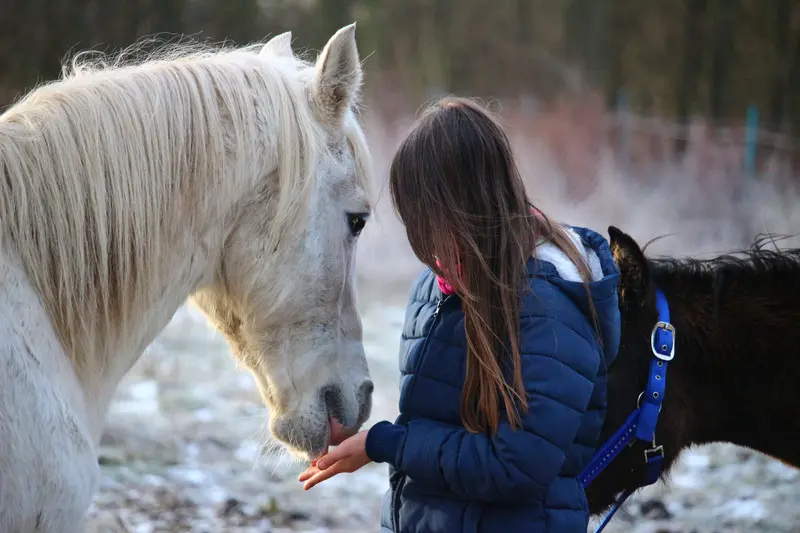
Advantages
- Easy to Measure and Mix: One of the main advantages of alfalfa pellets is their uniform size and shape, which makes them easy to measure and mix with other types of horse feed. This allows for more accurate portion control and helps ensure that your horse receives the appropriate amount of nutrients in their diet.
- Less Wastage: Due to their compact form, alfalfa pellets produce less waste than loose hay or other forms of forage. Horses are less likely to scatter the pellets, making it easier to keep their feeding area clean and ensuring they consume the entire portion.
- Reduced Risk of Choking: The small size and softer texture of alfalfa pellets make them easier for horses to chew and swallow, reducing the risk of choking compared to larger, coarser feed options like hay cubes or bales.
- More Consistent Nutrient Content: Alfalfa pellets provide a consistent nutrient profile since they are made from carefully processed and blended alfalfa. This ensures that your horse receives a stable and balanced supply of essential vitamins, minerals, and proteins in their diet.
Disadvantages
- May Require Soaking for Some Horses: Some horses, especially older ones with dental issues or those prone to choke, may require their alfalfa pellets to be soaked in water before feeding. Soaking softens the pellets, making them easier to chew and swallow, but it also adds an extra step to the feeding process.
- Less Palatable for Picky Eaters: While many horses enjoy the taste of alfalfa pellets, some picky eaters might find them less palatable than other feed options like fresh hay or alfalfa cubes. In these cases, it may be necessary to gradually introduce the pellets into their diet or mix them with other types of feed to encourage consumption.
Alfalfa Cubes
Alfalfa cubes are another popular form of horse feed made from compressed alfalfa hay. The production process involves cutting and drying the alfalfa, followed by chopping it into smaller pieces. These pieces are then compressed into cube shapes, typically around 1-2 inches in size, using a hydraulic press. The result is a nutrient-rich, compact, and easily stored horse feed option.
Advantages
- Encourages Natural Grazing Behavior: Alfalfa cubes more closely resemble natural forage, which can encourage a horse’s natural grazing behavior. This can lead to a more satisfied and content horse, as it allows them to engage in a more instinctual feeding pattern.
- Can Help Slow Down Consumption Rate: Due to their larger size and increased density, alfalfa cubes can take longer for horses to chew and consume compared to pellets. This slower eating pace can help prevent overeating and promote better digestion, especially in horses that tend to eat too quickly.
- Less Dust and Allergens: Alfalfa cubes generally produce less dust compared to loose hay or even alfalfa pellets. This can be particularly beneficial for horses with respiratory issues or allergies, as it reduces the amount of airborne irritants they may be exposed to during feeding.
- Easier Storage and Transportation: The compact and uniform shape of alfalfa cubes makes them easy to store and transport. They take up less space than loose hay, and their consistent size allows for efficient stacking and storage, making them a convenient option for horse owners with limited space.
Disadvantages
- More Expensive: Due to the additional processing and packaging required, alfalfa cubes can be more expensive than alfalfa pellets or loose hay. While the convenience and benefits may outweigh the cost for some horse owners, budget-conscious individuals may need to consider other options.
- May Require Soaking for Older Horses or Those with Dental Issues: Like alfalfa pellets, cubes may also require soaking in water before feeding to certain horses. Older horses or those with dental issues may struggle to chew the dense cubes, and soaking them can make it easier for these horses to consume the feed. This extra step can be a minor inconvenience for some horse owners, but it’s essential for the health and safety of the horse.
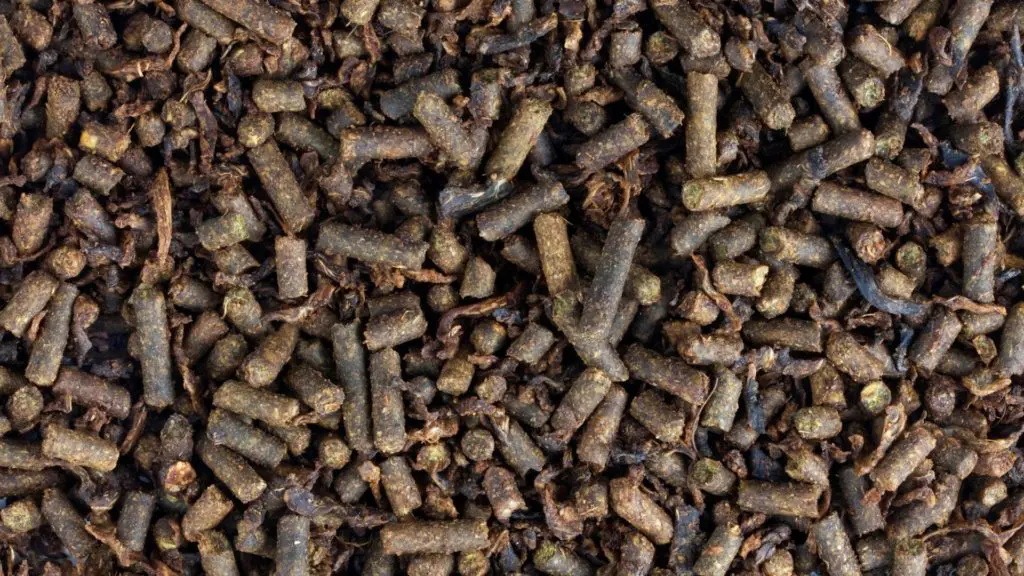
Factors to Consider When Choosing Between Pellets and Cubes
When deciding whether to feed your horse alfalfa pellets or cubes, there are several factors to consider. Each horse is unique, and it’s essential to take their individual needs into account when choosing the most suitable feed option.
Horse’s Age and Dental Health
The age and dental health of your horse plays a significant role in determining the most appropriate type of alfalfa feed. Older horses or those with dental issues may have difficulty chewing and swallowing denser feed like alfalfa pellets. In these cases, alfalfa cubes, which are softer, might be a better option. If necessary, soaking either pellets or cubes can also make them more manageable for horses with dental challenges.
Eating Habits and Preferences
Your horse’s eating habits and preferences should also be taken into account when choosing between alfalfa pellets and cubes. Some horses may prefer the taste and texture of one form over the other. Additionally, if your horse tends to eat too quickly, alfalfa cubes may help slow down their consumption rate and promote healthier digestion. On the other hand, if your horse is a picky eater, alfalfa pellets might be easier to mix with other feed to encourage consumption.
Allergies or Respiratory Issues
If your horse suffers from allergies or respiratory issues, the amount of dust produced by their feed can be a critical factor. Alfalfa pellets typically produce more dust than cubes or loose hay, making them a more suitable option for horses with respiratory sensitivities. However, it’s important to monitor your horse’s condition and consult with a veterinarian if you have concerns about their respiratory health.
Budget and Storage Limitations
Lastly, consider your budget and available storage space when deciding between alfalfa pellets and cubes. Alfalfa pellets can be more expensive than cubes, but they may offer benefits like reduced dust, easier storage, and a more natural feeding experience for your horse. If you have limited storage space, the compact size of pellets makes them a convenient option. However, if cost is a primary concern, alfalfa cubes may be the more budget-friendly choice.
Alfalfa Pellets Are More Convenient to Feed Than Cubes.
Alfalfa pellets kept in a drum are quickly scooped out and fed to your horses in a bucket. They need no premixing and are suitable for most horses straight from the bag. The biggest concern is that some horses gobble them down too fast and choke. And since there is a risk of choking, don’t leave your animal unattended when it’s eating pellets.
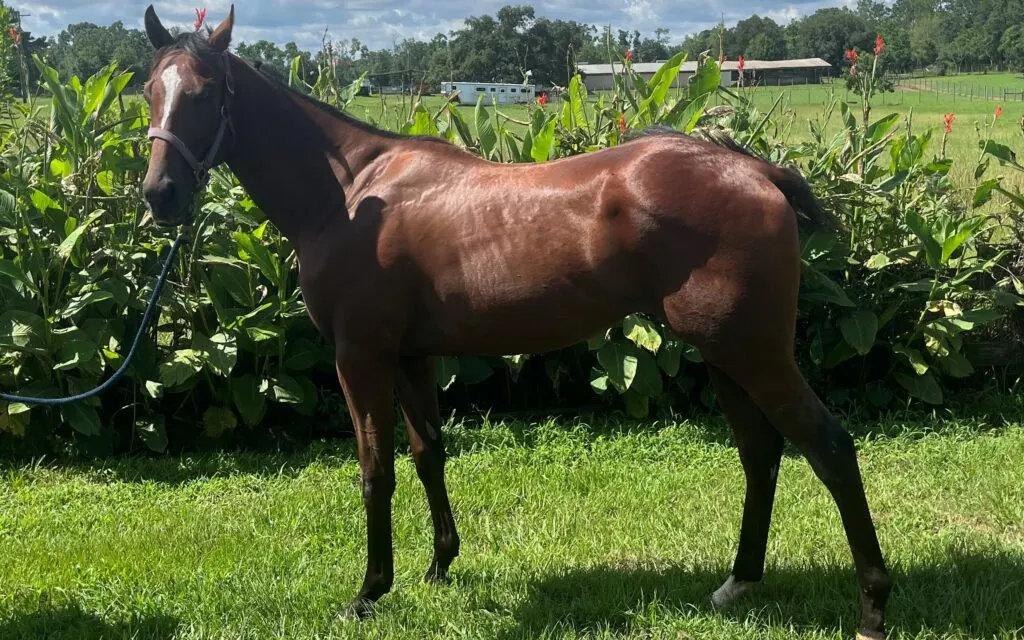
Forage Requirements.
Horses require long-stem forage for proper digestion, ideally consuming 1-2% of their body weight daily as hay, grass, or chaff. Pellets, being too processed and small, lack the necessary long-stem fiber and are not suitable hay substitutes. Alfalfa cubes, however, retain some long-stem fiber benefits and can replace hay when needed.
Forage is crucial to a horse’s diet, second only to water. While pellets cannot fully replace hay, they can supplement other forage options when used in conjunction with alfalfa cubes or available pasture grass.
Alfalfa Cubes and Pellets Can Cause Colic.
Two primary causes of colic in horses are overeating and diets that include grains or concentrated foods. If allowed, horses eat more alfalfa cubes and pellets than is healthy. And pellets are concentrated in alfalfa hay, increasing the risk of colic.
A horse will likely eat all the alfalfa cubes they have available, but when fed alfalfa hay, they are picky and often waste some. Overall it’s believed if a horse is given the opportunity, it will be up to 25% more alfalfa cubed than long-stem hay.
Overeating alfalfa leads to obesity and colic. Pellets have two problems related to colic, overeating and being concentrated. Because pellets aren’t long-stem forage, they don’t move food through the digestive tract, leading to colic. It’s critical to ration alfalfa cubes and pellets.
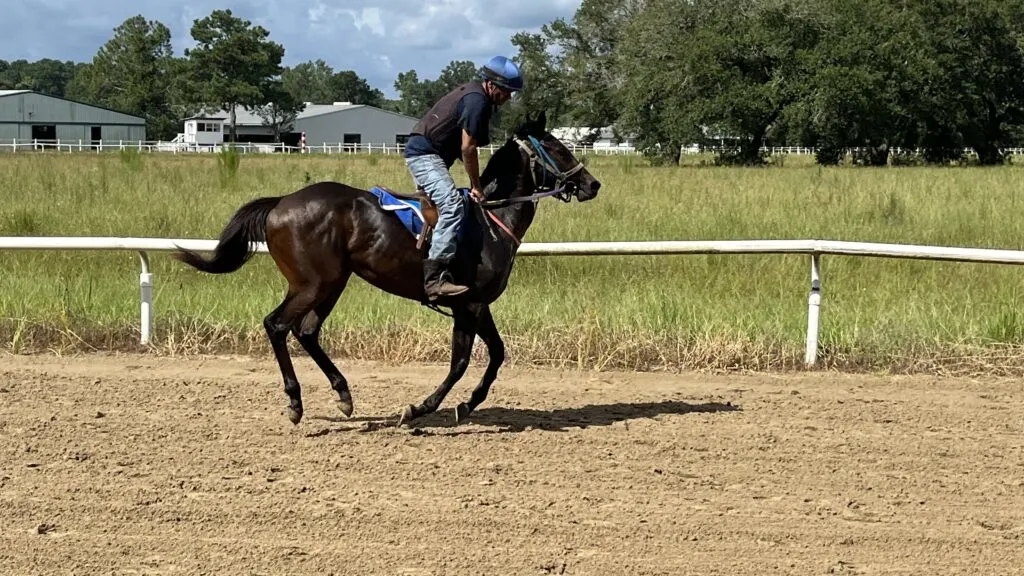
How Much Alfalfa Pellets to Feed a Horse?
If you’re thinking about adding alfalfa pellets to your horse’s diet, you might be wondering how much you should feed them. The answer depends on a few factors, including the age and weight of your horse, as well as their activity level.
Generally speaking, adult horses should receive 15 to 20 pounds of alfalfa pellets per day, while younger horses or those who are very active may need up to 25 pounds. When feeding alfalfa pellets, it’s important to gradually introduce them into your horse’s diet to avoid gastrointestinal distress.
Start by feeding a small amount and increase gradually over the course of a week or two. You should also make sure that your horse has access to fresh, clean water at all times. By following these simple guidelines, you can help ensure that your horse stays healthy and happy.
How Many Alfalfa Cubes Should a Horse Eat a Day?
I recently started feeding our horses alfalfa cubes but was unsure how much to feed our horses. So, I decided to research alfalfa cubes to learn how much to feed my horses each day. The amount of alfalfa cubes you feed a horse is dependent on the size and workload of the animal. Generally, horses eat between 1 1/2-2 lbs. of their body weight.
If a horse is training or working hard, its calorie needs increase. A typical horse weighing 1,100 lbs. should eat approximately 16 pounds of alfalfa cubes per day. Horses are individuals, and you should adjust their diet based on their fitness level and body condition. If you notice your horse losing weight, feeding 1.5% of its body weight in alfalfa increases the volume of cubes you’re providing.
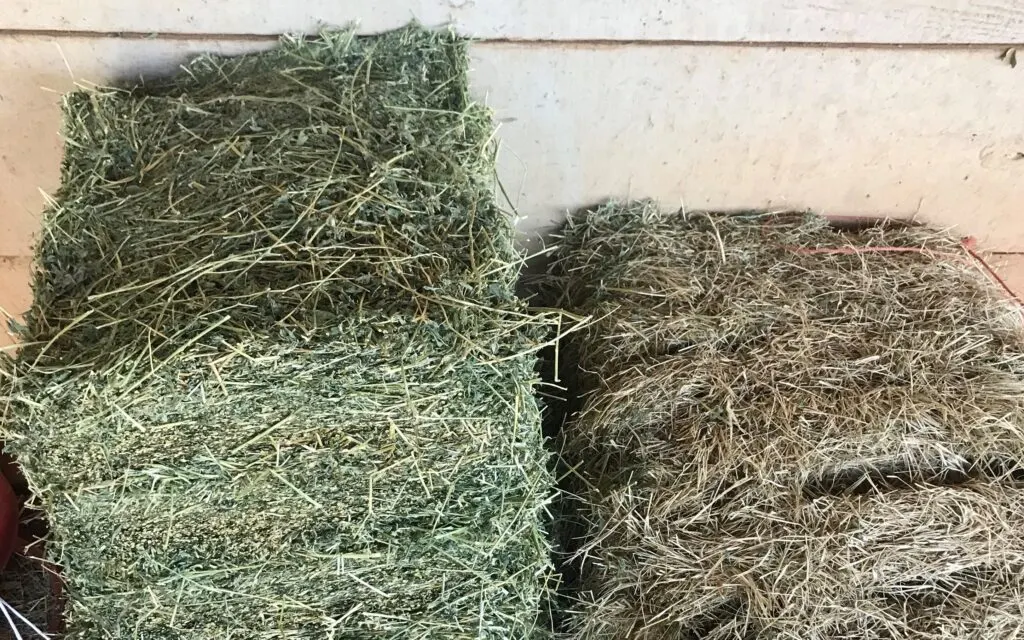
Are Alfalfa Pellets and Cubes as Good as Alfalfa Hay?
Some of my old-school horse buddies will always feed alfalfa hay and aren’t convinced that alfalfa pellets and cubes are as beneficial to horses as feeding hay. So I decided to research the benefits of hay over cubes and pellets.
Eating hay benefits horses in ways not obtainable by eating pellets or cubes. For instance, horses fed hay spend more time grazing, which produces saliva, promotes dental and digestive health, and prevents boredom.
Many owners believe in feeding hay to their horses, but there are some advantages to feeding pellets and cubes.
Alfalfa is high-quality hay.
Horses are grazing animals with small stomachs; because of this, they benefit from eating small amounts over a long period. Food comes into their stomach and passes through relatively quickly to their hindgut. Also, the long fibers of hay form barriers that soak up acids preventing ulcers in the stomach.
Because the speed horses eat cubes and pellets, they are susceptible to colic and boredom. However, colic can occur for various reasons, but to reduce the risk, feed small portions of soaked cubes and pellets to manage their intake.
Grazing horses keep their minds occupied, picking through and eating hay and grass; horses that eat cubes and pellets often eat fast and have idle time, which leads to boredom and cribbing. Horses allowed to graze are continually chewing, which helps wear their teeth consistently, resulting in better dental health. Grazing horses typically need less dental care.
Chewing also creates saliva in the horse’s mouth, which provides moisture to the food and lubricates the intestines. The increased saliva decreases the risk of impaction and ulcers. Alfalfa is palatable and a highly digestible food source for horses. It is a good energy source of proteins, minerals, and vitamins and is readily available across the United States.
High-quality alfalfa should be leafy and bright green. The leaves are where the protein and vitamins reside, and the bright green color indicates proper curing, lack of mold, and carotene content.
| Type | Nutritional value | Price | Storage | Palatability |
|---|---|---|---|---|
| Alfalfa pellets | 16% protein, 1.5% crude fat, and 30% fiber | Prices vary from 15-40 dollars per 40 lb bag. | Bags easy storage: 3/16ths to 1/2 inches pellets | Tasty and easy to consume. Soaking slows eating and softens for senior horses. |
| Alfalfa cubes | 16% protein, 1.5% crude fat, and 30% fiber | Prices vary from 15-40 dollars per 40 lb bag. | Bags easy storage: 1 1/2 to 2-inch cubes | Tasty but hard, best fed broken and soaked in water. |
| Alfalfa hay | Each bale is different. Must be analyzed | Prices vary by region | 21 in wide, by 16 inches high, by 3 to 4 feet long. | Tasty hay, long-stem forage. |
There are some advantages of pellets and cubes over hay.
Pellets and cubes are easy to pack and feed when trailering your horse long distances. Cubes and pellets take less storage space, and there is no waste. There is always a lot of hay left on the ground that needs to be picked up and discarded in hay storage areas.
When feeding hay to horses, they often only eat the leaves and leave the stems; they consume the entire product with pellets. Bagged alfalfa is nutrient consistent, and you know you’re getting what you pay for.
The manufacturer labels each bag so you can adjust your horse’s diet quickly. Both Alfalfa cubes and pellets have less dust than hay and are an excellent alternative forage source for horses with respiratory issues.
Pellets are an excellent way to get calories and protein in a senior horse with missing or broken down teeth. Well-softened hay pellets may be the only nutritious food source the horse can eat. In addition, the nutrient value of pellets and cubes is pretty consistent.
One pound of alfalfa pellets and one pound of cubes provide the same amount of protein, fat, and fiber as a pound of alfalfa hay. However, alfalfa hay protein varies considerably based on the age it’s cut, where it’s grown, and how it is cured and stored. In order to get an accurate measure of the hays’ nutritional value, it has to be analyzed. Note: Horses build and maintain their large muscular bodies by consuming forage.
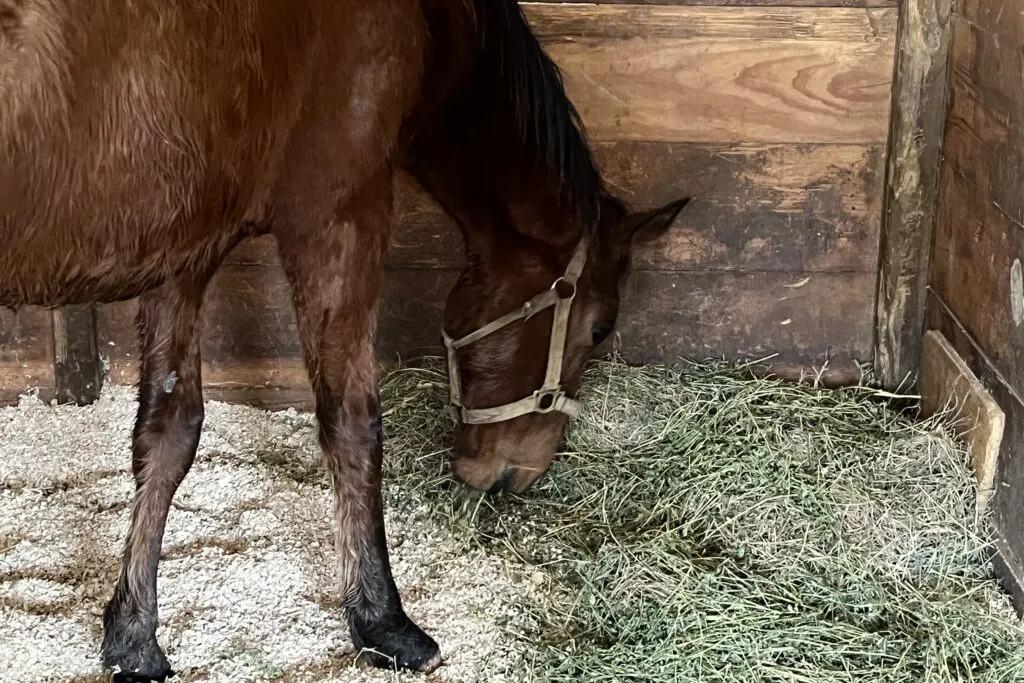
Take Your Time When Switching From Hay to Pellets.
Horses have a sensitive digestive system that’s easily disrupted when their diet changes. For this reason, changes must be made gradually over ten days to two weeks; if not, colic or other digestive disorders are a risk.
Introduce the pellets by adding them to the top of your horse’s hay ration while simultaneously cutting back on its hay. Gradually increase the pellets and reduce the hay you regularly feed your horse.
Remember, pellets are not a substitute for all your horse’s forage needs, they can replace alfalfa hay if your animal has other hay or grass, but a horse must consume long-stem forage for proper digestion. Also, note that one pound of alfalfa pellets has the same nutritional value as one pound of hay.
Below is a YouTube video that explains the benefits of alfalfa pellets and cubes.
Summary
Both alfalfa pellets and cubes have their advantages and disadvantages when it comes to feeding your horse. The decision ultimately depends on factors such as your horse’s age, dental health, eating habits, allergies, and budget and storage constraints.
It’s essential to consider your horse’s unique needs and consult with an equine nutritionist or veterinarian for personalized advice. Remember, forage is a vital part of your horse’s diet, and finding the right balance between pellets, cubes, and other forms of forage will ensure their health and well-being.
Alfalfa cubes prove to be a superior option compared to pellets for our needs. Cubes successfully serve as a convenient, nutrient-rich, and low-waste substitute for hay. The primary challenge lies in managing the horse’s daily intake. Although we don’t foresee completely replacing hay with cubes, they present a viable alternative. For more information on horse feeding, check out this informative article: What Does a Horse Eat? An Essential Feeding Guide.
FAQ
Is Bermuda hay bad for horses?
No, bermudagrass hay isn’t bad for horses, but it lacks all the protein, essential minerals, and vitamins horses need. On a positive note, it has a high fiber content which helps horses digest food and absorb nutrients.
You can learn more about Bermuda hay in this article: Bermuda Hay – Is It Good for Your Horse? 5 Facts to Ponder.
Does feeding beet pulp to your horse cause diarrhea?
Beet pulp doesn’t typically cause diarrhea in horses. In fact, many horse owners feed beet pulp to their horses with diarrhea because it’s high in fiber and dry content, which helps concentrate the stomach liquid.
You can learn more about the advantages and disadvantages of feeding your horse beet pulp in this article: Feeding Beet Pulp to Horses: the Good and the Bad.
Resources:
Standlee is the premier manufacturer of alfalfa pellets and cubes. The prices from Amazon are high, but I provide you with a link to read the reviews of what customers have to say about their products. The pellets have a 4.8 out of 5 stars rating, and the cubes received 4.5 stars.
Meet Miles Henry
An avid equestrian and seasoned racehorse owner, Miles Henry brings his extensive experience to the equine world, proudly associating with the AQHA, The Jockey Club, and various other equine organizations. Beyond the racetrack, Miles is an accomplished author, having published various books about horses, and is a recognized authority in the field, with his work cited in multiple publications.
🔗 Connect with Miles:
Twitter
Facebook
YouTube: Check out race highlights, horse care tips, and more!

